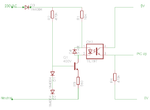pradhan.rachit
Full Member level 3
Hello Experts,
I have am constructing a circuit which requires isolated zero crossing detection, but only the positive half of it.
The standard ZCDs using a full wave rectifier and an opto-isolator produce pulses at both the zero crossings (positive and negative half)
I found a circuit here https://www.chatzones.co.uk/discus/messages/12743/12815.html?1323198789 that half wave rectifies the signal and drives the opto-LED via a transistor.
I am not sure of its behaviour during the negative half of the input. Can someone please explain if and how it would fit my requirement?
Attached below is the image that I found.

Thanks!
I have am constructing a circuit which requires isolated zero crossing detection, but only the positive half of it.
The standard ZCDs using a full wave rectifier and an opto-isolator produce pulses at both the zero crossings (positive and negative half)
I found a circuit here https://www.chatzones.co.uk/discus/messages/12743/12815.html?1323198789 that half wave rectifies the signal and drives the opto-LED via a transistor.
I am not sure of its behaviour during the negative half of the input. Can someone please explain if and how it would fit my requirement?
Attached below is the image that I found.

Thanks!